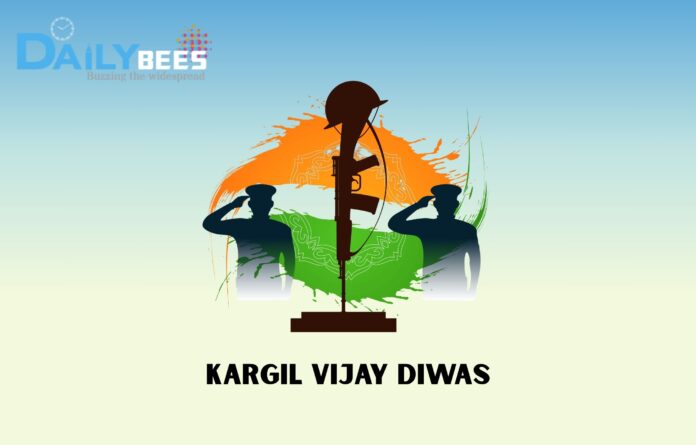Table of Contents
Kargil Vijay Diwas 2025: Honoring India’s Bravehearts
Kargil Vijay Diwas, celebrated on July 26th, is India’s day of remembrance for the Operation Vijay in 1999. In this high-altitude campaign, the Indian forces pushed back Pakistani infiltrators in Kargil. Every year on this day, the nation honors the valour and sacrifice of the soldiers in the Kargil war. This year, the commemoration takes on special meaning. The Army has launched an unprecedented Nationwide outreach drive to personally connect with the families of the 545 personnel. The teams will cover 25 states, 2 union territories, and even Nepal to deliver letters of gratitude, momentos, and welfare information to every next of Kin. Public ceremonies, from school events to cantonment gatherings, are also held on this day that lead up to a solemn wreath-laying at the Dras War Memorial in Kashmir.
Remembering Kargil and Operation Vijay
For India, the Kargil War was a turning point. Indian forces learnt in May 1999 that Pakistani troops had secretly taken over mountain posts on the Indian side of the Line of Control (LoC) in Kashmir. The Indian Army fought a bloody, high-altitude battle to clear these peaks over the following ten weeks, assisted by aircraft. To regain the strategic heights, Operation Vijay, which translates to Victory, was initiated. The Army had retaken Tiger Hill, Tololing, and other strategic locations in the Kargil and Dras sectors by the end of July. India regained control of the key mountain ridgelines after declaring victory on July 26, 1999.
The cost of this war was high. Indian sources report 527 soldiers killed and 1,363 wounded during the conflict. The army commemorative releases round this up to 545 martyrs. Kargil Vijay Diwas not only marks this victory but also celebrates the heroism, strategy, and restraint shown in that war. As one report notes, India’s forces reclaimed key positions in the Kargil-Siachen sector and carried out a coordinated tri-services strategy under challenging conditions. For many, the war’s legacy is also a lesson in vigilance. Kargil demonstrated how quickly even remote posts can be threatened if left unguarded.
Today’s commemoration is filled with pride and humility. Citizens recall stories of young officers like Capt. Vikram Batra and Lt. Manoj Pandey earning Param Vir Chakras, and ordinary soldiers storming icy peaks under fire. But equally prominent is the belief that our brave hearts deserve more than just ceremonies; they deserve lasting support. This year, the Army’s Two‐Month Kargil Tribute (starting June 2025) is specifically designed to honor every aspect of the war’s impact. As media coverage states, the tribute aims to celebrate the courage, sacrifice, and indomitable spirit of those who defended the border in 1999. A key part of that celebration is reaching out to their families.
Honoring Martyrs: The 2025 Outreach Drive
This summer, the Indian Army has turned the phrase ‘We remember’ into a tangible reality. For the first time, teams of officers and soldiers are visiting the Next of Kin of every Kargil martyr across India. Each visit is a heartfelt moment known locally as the Kargil Martyr Outreach Drive 2025, which combines ceremony with compassion. The Army’s presentations include a letter of gratitude from the Chief of Army Staff, a commemorative keepsake, and informational packets detailing pensions and other benefits. Importantly, the teams listen to widows, parents, and siblings, learning about their long-term needs, and promise further assistance.
One touching example happened in the hills of Ladakh. As Voice of Ladakh reported, Havildar Haider Ali of 508 ASC Battalion undertook a three-day trek over treacherous terrain to reach Stongde village in Zanskar. There he met Smt. Tsering Chhuskit, widow of Havildar Chhering Tashi (a Ladakh Scouts hero of Kargil). The meeting was marked by deep emotion and solemn respect. Hav. Ali personally conveyed the Army’s gratitude and solidarity. He presented Chhering Tashi’s family with a letter of appreciation and a unit memento. The widow later said she was heartfelt in her thanks, grateful that the Army had ventured to her remote village, just to honor her husband’s sacrifice.
Such stories are mirrored across the country. Similar ceremonies are held in Kashmir, Siachen, and even Nepal. This outreach shows our Army’s spirit of shared sacrifice. This personalized approach is unprecedented.
Memorial Ceremonies and Lasting Legacy
Kargil Vijay Diwas is observed with ceremonies at war memorials and cantonments across India. Schools organize tributes, veterans speak at parades, and the media share stories of Kargil with younger generations. The main event, however, takes place in Dras, where the mountains serve as witnesses to the sacrifices made. On July 26, 2025, senior officers and local dignitaries will lay wreaths at the Dras War Memorial. This solemn ceremony reaffirms that India never forgets its fallen heroes.
In Dras, each snowfall and pine-lined approach reminds visitors of the long nights and fierce battles of Kargil. Photos of young cadets saluting veterans, or generations of a martyr’s family standing at attention, serve as powerful reminders. Advocates say these remembrances should extend beyond July 26, urging that Kargil’s lessons be taught in schools and that every Indian witness the Dras memorial at least once.
The spirit of Kargil Vijay Diwas is both reflective and forward-looking. We honor the past, the snowy mountain forts won in 1999, and the 545 sons and daughters who paid the price. But the ceremonies and outreach also inspire a better future, reminding current and future soldiers of the values of service, humanity, courage, and sacrifice. In that sense, every wreath laid and every grieving mother consoled becomes part of India’s ongoing story, that of a nation determined to remember its heroes in word, in deed, and unwavering action.













